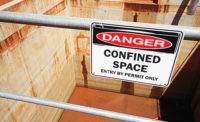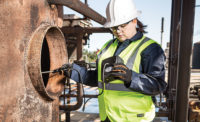Many confined spaces contain inherent risks and dangers, such as hazardous materials or gases, oxygen-deprived environments, or materials that could engulf and trap a worker. Over 30 different industries are affected by the hazards of confined space entry, including construction, water and sewer operations, agriculture and farming, the petrochemical industry, utility workers and miners.
The Bureau of Labor Statistics (2002) reports an average of 20 fatalities a year from confined space hazards. More than half of the fatality victims are attendants who become would-be rescuers.
These statistics indicate the vital need for confined space attendants and other rescue personnel to receive the proper safety training to create awareness of hazards and be trained on best safety practices to prevent rescues from becoming body retrievals.
OSHA's Permit-Required Confined Spaces Standard 1910.146 provides specific training requirements for rescue personnel. Many training programs covering this regulation are available. These programs must certainly be accurate, but to be truly effective they also need to be interesting and compelling in order to hold trainees' attention.
Let's look at some of the central issues that should be covered in a comprehensive confined space safety training program.
Common hazards
The main hazards encountered in confined spaces are fire or explosion, asphyxiation, toxicity, drowning in liquids or free-flowing solids and injury or death if mechanical equipment within the confined space is inadvertently turned on while someone is still inside. These hazards are due to the presence of hazardous gases, vapors, fumes, dusts or the creation of an oxygen-deficient or oxygen-rich atmosphere.When a confined space has been defined as "permit required," one or more of the following hazards has been identified:
- Hazardous atmosphere, meaning the air inside the confined space is, or could become, dangerous.
- Potential to engulf or trap the employee in materials that are present within the confined space.
- Configuration or shape that could potentially trap an employee inside, such as a sloping floor.
- Other hazards, such as machinery, electricity or extreme cold or heat.
Hazardous atmospheres cause more than 40 percent of the injuries and deaths in confined space situations. A hazardous atmosphere is one that includes too little oxygen (less than 19.5 percent) or too much oxygen (greater than 23.5 percent), unsafe amounts of combustible gas, vapors, dust or mist, and harmful levels of toxic substances.
Training should include the importance of air quality testing prior to entry to determine whether or not the atmosphere in a confined space is hazardous.
Organic matter
Often, workers make the mistake of thinking that only confined spaces that contain dangerous materials present hazards. Two examples of confined spaces where no dangerous goods are stored but hazards exist are sewers and hay and grain silos.In sewers, decomposing organic matter, such as domestic waste or plant life, may produce flammable gases (methane), flammable and toxic gases (hydrogen sulphide) asphyxiant gases (carbon dioxide) and an oxygen-deficient atmosphere due to rust or bacterial respiration. Defective wiring in a wet atmosphere may also pose an electrocution hazard to an employee.
Hay and grain silos house the potential for dust explosions. Grain may also collect and form a bridge or dome across a bin. This grain may fall and entrap or suffocate a grain worker. An employee may be injured while working inside a silo if an auger or other piece of equipment is turned on. Fermentation of corn, wheat, potatoes and other crops may give off large quantities of carbon dioxide gas and ethyl alcohol. Toxic nitrogen dioxide gas is also formed when nitric oxide in fresh silage comes in contact with oxygen. The grain in the silo may also have been treated with a fumigant, which slowly releases toxic and flammable phosphine gas under humid conditions.
Attendant's duties
Confined space entry regulations require that an attendant be present every time a permit required confined space is entered. The attendant is stationed outside the permit space to monitor the authorized entrants inside and perform all the attendant's duties defined in the permit space program. These responsibilities include:
- Knowing the hazards that may be encountered during an entry.
- Knowing the possible hazardous materials or possible exposures in the confined space.
- Tracking all authorized entrants in the permit space and ensuring the names of the authorized entrants are listed on the entry permit.
- Remaining stationed outside the permit space at all times until all work is completed or until another attendant relieves him/her.
- Communicating with authorized entrants to monitor their status and to alert entrants if they must evacuate the permit space.
- Summoning emergency and rescue services when needed.
In accidents where more than one death occurred in permit required confined spaces, most victims died while trying to rescue a co-worker from a confined space. These would-be rescuers account for more than 60 percent of confined space deaths.
In emergency situations, emotions can often take control and people can act on impulse. A natural impulse is to offer help to someone in need. Therefore, some attendants rush in to the confined space to offer assistance to a trapped, injured or struggling partner. Unfortunately, while the intentions are good, the results are often disastrous. Good training must instill in the attendant the proper response to any emergency, thus lessening the likelihood of mistakes motivated by emotions, panic or misplaced instinct.
Managing lines
A point for further consideration for attendant safety is how to properly manage all of the lines going into a space during a rescue operation. Rescuers typically carry a hard-line communication cable, retrieval line and an airline for breathing apparatus. When multiple entrants, numerous lines and a retrieval system for the victim are combined, the result can be chaotic with a tangle of lines in and around the hole entrance.
Tripping hazards, entanglement problems, frustration and panic are often the result of poorly managed lines. Teams can benefit by taking the time to consider which methods of line management best suit their operational requirements, assign team member(s) to the actual task and practice line tending skills during exercises.
Practice makes perfect
An efficient and optimal response is vital to a successful confined space rescue. Proper training and practice are two ways to ensure speed and accuracy. In a crisis situation with emotions running high, the best trained and prepared attendants are more likely to react properly. The way to prevent workers from reacting on impulse is effective safety training and rescue pre-planning. However, for training to be truly effective, workers must be engaged in the training, paying attention to the material being presented.
The goal of any safety training effort is to increase awareness of potential risks and hazards and to teach best safety practices to the workers who face such risks on a daily basis. Effective safety training is all the more important with a serious issue such as confined spaces.
SIDEBAR: Four foundations
A comprehensive confined space entry safety program should include information on the following foundational points:
- Definitions of what comprises a confined space;
- How to identify and evaluate confined space hazards;
- Communicate permit procedures for entry into confined spaces;
- Identify which confined spaces are permit required and which can be entered without a permit.

